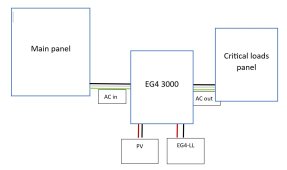JustOnePanel
New Member
Greetings,
I'm building a small solar system (1 x EG4 3000, 1 x EG4-LL, 2kW PV) to power a critical loads panel for a couple of hours max. In my area in NJ we get short power outages due to storms etc that this setup will cover, I've mapped out power usage via an emporia vue. EG4 will prioritize utility power over battery. Anything longer than that I can fire up the 240V generator and power up the main panel via interlock.
I was planning to move 4 loads (fridge, chest freezer, furnace, 1 set of LEDs) on a single phase critical loads panel, without bridging to the other phase, fed by a single 120V EG4 3000. But as part of my prep work I realized the 2 kitchen circuits for the fridge and the freezer are MWBCs. Fridge 20A circuit is sharing neutral with the gas range/range fan circuit and the freezer is on the kitchen outlets 20A GFCI circuits.
I could "undo" the MWBCs by running 2 new 12/2s but cost and labor-wise it may be much easier to buy a 2nd EG4 3000 and configure it for split phase, purely to handle the MWBCs as there won't be any 240V loads. I'm comfortable doing the work myself and have it inspected/permitted.
Would that work? Is there a better way to deal with MWBCs?

I'm building a small solar system (1 x EG4 3000, 1 x EG4-LL, 2kW PV) to power a critical loads panel for a couple of hours max. In my area in NJ we get short power outages due to storms etc that this setup will cover, I've mapped out power usage via an emporia vue. EG4 will prioritize utility power over battery. Anything longer than that I can fire up the 240V generator and power up the main panel via interlock.
I was planning to move 4 loads (fridge, chest freezer, furnace, 1 set of LEDs) on a single phase critical loads panel, without bridging to the other phase, fed by a single 120V EG4 3000. But as part of my prep work I realized the 2 kitchen circuits for the fridge and the freezer are MWBCs. Fridge 20A circuit is sharing neutral with the gas range/range fan circuit and the freezer is on the kitchen outlets 20A GFCI circuits.
I could "undo" the MWBCs by running 2 new 12/2s but cost and labor-wise it may be much easier to buy a 2nd EG4 3000 and configure it for split phase, purely to handle the MWBCs as there won't be any 240V loads. I'm comfortable doing the work myself and have it inspected/permitted.
Would that work? Is there a better way to deal with MWBCs?



